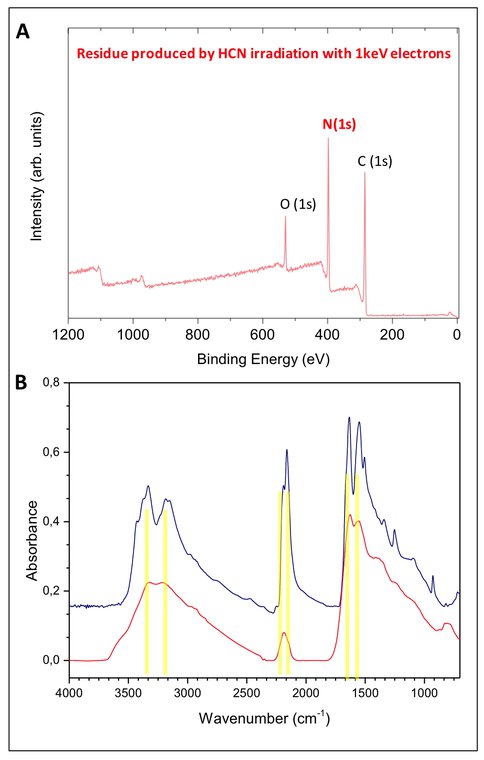2012 Annual Science Report
 NASA Jet Propulsion Laboratory - Titan
Reporting | SEP 2011 – AUG 2012
NASA Jet Propulsion Laboratory - Titan
Reporting | SEP 2011 – AUG 2012
Task 3.1.1.2 Reactions of Organic Ices With Electrons (Part 2)
Project Summary
Secondary electrons can stimulate the polymerization of HCN. These electrons are present at low altitudes and in the near surface regions of Titan and not only lead to polymerization, but also negative charging of the haze particles.
Project Progress
Co-Investigator Thom Orlando and colleagues seek to understand how secondary electrons produced by primary electrons with energies in the range of 0.1-1 keV stimulate the polymerization of HCN. These electrons are present at low altitudes and in the near surface regions of Titan and not only lead to polymerization but also negative charging of the haze particles.
The negative charge pickup in a complex tholin film was probed using ESD experiments and electrostatic force microscopy (EFM) measurements. ESD experiments performed at 140K under ultra-high vacuum showed an earlier time of flight for H- coming off a tholin film formerly exposed to 50 eV electrons. The H- kinetic energy is increased due to a change in the tholin film’s work function. It was estimated from this experiment that the tholin film produced by AC discharge (sample provided by Mark Smith) could easily build a surface potential of about 2 eV when exposed to electrons. The surface potential of 2 eV corresponds to a pickup of electrons that are likely trapped due to the presence of the NHx and CN groups in the tholins, which have large electronegativities. An experiment performed at room temperature using EFM confirmed a surface potential of about 2 eV across a tholin residue produced by the same method.
Similar behavior regarding electron pickup was suspected for HCN ice after low-electron energy irradiations. Therefore, a thorough investigation of the changes observed after electron irradiation of condensed HCN at 90K on graphite and SiO2 was done with 1 keV electrons. Graphite and SiO2 were used as surrogates of carbonaceous and siliceous chondrites, respectively. At high electron densities, a macroscopic transformation is observed in HCN ice leading to the formation of a tholin-like residue on the graphite substrate. FT-IR measurements showed a very similar line profile to that of tholin films produced by AC or RF discharges (Figure 1B).
Furthermore, XPS measurements showed that the residue had significant nitrogen content (Figure 1) with an N/C atomic ratio of about 68%. XPS spectral lines were deconvoluted into several contributions for each atom, revealing the molecular complexity. The deconvoluted lines suggest the presence of amines, nitriles, and heterocycles within the residue. In addition, small oxygen incorporation is observed with the contribution of an amide functional group deconvoluted from the XPS spectrum.
At low-electron densities, the CN stretch of condensed HCN probed with FT-IR shows the formation of a shoulder, suggesting the formation of carbon triple bonds or conjugated nitriles. TPD experiments of HCN processed by 1keV electrons revealed the presence of a significant amount of H2 desorption due to either direct fragmentation of HCN or as a daughter ion issued from a heavier parent molecule (polymer).
These experiments show that Titan haze particles exposed to electrons could build a surface potential that would potentially drive new chemical reactions by picking up and keeping available surrounding electrons. Moreover, HCN condensates on graphite and SiO2 are shown to “polymerize” under 1keV electron irradiation, forming aerosols possessing IR signatures quite similar to the expected Titan tholins. The experiments suggest that HCN “polymerization” could also occur at lower energies within a longer time frame.
Figure 1. A) XPS spectrum of the residue produced by HCN irradiation with 1 keV electrons at 90K. B top) IR spectrum of tholins produced by AC discharge, sample provided by Mark Smith. B bottom) IR spectrum of the residue produced by HCN irradiation with 1 keV electrons at 90K. Both spectra present very similar features.
-
PROJECT INVESTIGATORS:
-
RELATED OBJECTIVES:
Objective 2.2
Outer Solar System exploration
Objective 3.1
Sources of prebiotic materials and catalysts
